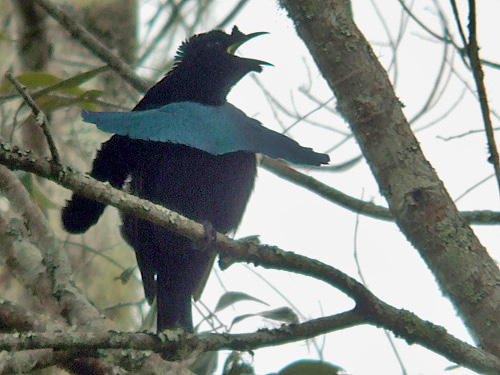(→Behaviour: Update link) |
m |
||
| Line 55: | Line 55: | ||
==External Links== | ==External Links== | ||
{{GSearch|Lophorina+superba}} | {{GSearch|Lophorina+superba}} | ||
| − | |||
[[Category:Birds]][[Category:Lophorina]] | [[Category:Birds]][[Category:Lophorina]] | ||
Revision as of 20:42, 12 February 2017

Photo by Xenospiza
Aluakambe, Tari Valley, Southern Highlands, Papua New Guinea, July 2006
Alternative name: Lesser Superb Bird-of-Paradise
- Lophorina superba
Identification
Male 26cm, female 25cm.
Male
- Velvety jet-black head
- Iridescent metallic green-blue crown
- Velvety jet-black erectile nuchal cape with dark olive-green iridescence
- Black back and rump
- Velvety jet-black throat with dark olive-green sheen
- Metallic greenish-blue breast shield
- Slightly glossy black underparts
- Dark brown eye
- Black bill
- Lemon-yellow to lime-green mouth
- Blackish legs
Female
- Blackish-brown head and nape with short line of tiny whitish spots as postocular line
- Similar submoustachial stripe
- Cryptically brown and rufous coloured upperparts
- Whitish-grey chin and throat
- Pale buff to olive-tinged brown (latipennis) underparts, narrowly barred blackish-brown
Juveniles and immature are similar to females.
Similar species
Females can be confused with females of Magnificent Riflebird (note bill length) and some female Parotias.
Distribution
Endemic to the mountains of New Guinea.
Locally common and often most common Bird-of-Paradise in its altitudinal range.
Taxonomy
Five subspecies currently recognized:
- L. s. superba at Vogelkop, northwest New Guinea
- L. s. niedda on Mount Wondiwoi, northwest New Guinea
- L. s. feminina in the central mountain chain from Weyland Mountains east to central New Guinea
- L. s. latipennis in east and northeast New Guinea in Eastern and Central Highlands
- L. s. minor in the mountains of southeast New Guinea
The proposed subspecies connectens is usually treated as a synonym of latipennis. The proposed subspecies sphinx is of unknown origin, possibly from far southeast New Guinea.
Hybrids with Long-tailed Paradigalla, Western Parotia, Carola's Parotia, Magnificent Riflebird, Black Sicklebill and Magnificent Bird-of-Paradise recorded.
Habitat
Middle and upper montane forest. Also in disturbed forest and forest patches among gardens. Iccurs at 1000 - 2300m, mainly at 1650 - 1900m.
Behaviour
Diet
Feeds mostly on fruits and a variety of arthropods.
Forages at all forest levels, usually singly.
Breeding
Breeds in any month across range, display observed from August to January. A polygynous species. The male advertises from a traditional high perch and performs its display. The female builds and attends the nest alone.
The courtship involves a static display and an animated dance. The erection of the nuchal cape and the pectoral shield are important features.
The nest is a rough cup, placed 1.5m or higher above the ground in a palm. Lays 1 - 2 eggs.
Movements
Presumably a resident species.
References
- Clements, JF. 2009. The Clements Checklist of Birds of the World. 6th ed., with updates to December 2009. Ithaca: Cornell Univ. Press. ISBN 978-0801445019.
- Del Hoyo, J, A Elliott, and D Christie, eds. 2009. Handbook of the Birds of the World. Volume 14: Bush-shrikes to Old World Sparrows. Barcelona: Lynx Edicions. ISBN 978-8496553507
Recommended Citation
- BirdForum Opus contributors. (2024) Greater Lophorina. In: BirdForum, the forum for wild birds and birding. Retrieved 26 June 2024 from https://www.birdforum.net/opus/Greater_Lophorina



